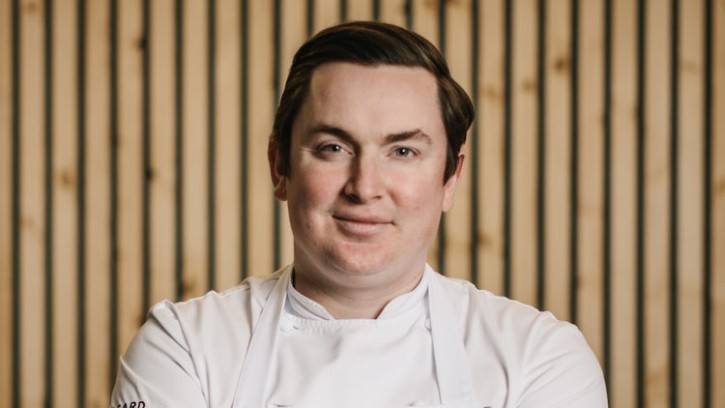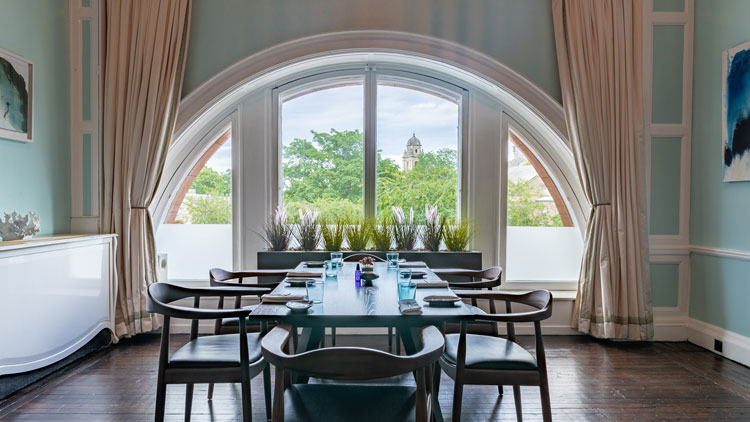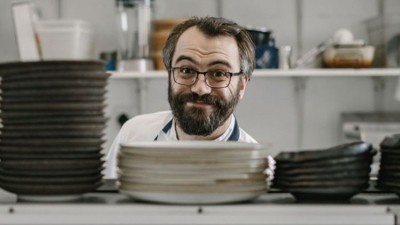Haar times: the Scottish chef building his own culinary fiefdom

Dean Banks has come a long way in the past few years. When Covid hit in 2020, he had a single site under his belt – Haar, a high-reaching seafood restaurant in St Andrews. Now, he has six. Alongside Haar, which in the interim has moved to a new location within St Andrews, they include fine dining restaurant Dean Banks at The Pompadour in Edinburgh; contemporary seafood concept Dulse, also in Edinburgh; Clackmannanshire pub The Forager; Dundee bar Temple Lane; and Dune, a cocktail bar and small plates place located a short walk from Haar in St Andrews.
That’s not all, though. Alongside his restaurants, Banks has two different meal kit businesses: Haar at Home, and Waagyu Burger. Plus, he owns his own premium vodka (Mond) and gin (Lunun) labels.
With so many plates spinning simultaneously, one wonders when he gets the time to rest. “I’m always working,” says Banks, with a chuckle, having briefly stepped away from prepping for service at The Pompadour. “I do about 100 hours a week. On the odd occasion when I do find myself at home on, say, a Friday night, it makes me feel like I should be doing more. As if I’m cheating the system somehow. And that drives me to do more.”
Taking on The Pompadour
We’re sat beside one of the grand arched windows in the dining room of The Pompadour, overlooking the majesty of Edinburgh Castle. Housed within one of the Scottish capital’s best-known hotels – the Waldorf Astoria Edinburgh — The Caledonian – the restaurant is something of a fine dining institution in the city, having first opened back in 1925. Previous custodians include the Galvin brothers, who oversaw the stoves between 2012 and 2019.
The opportunity for Banks to take over The Pompadour came about in the May of 2020, just as the city was preparing to emerge from the first Coronavirus lockdown. “It was fate that brought it to me,” he says, reflectively. “That’s always how these things come my way.
“Before the pandemic, I had been looking to come to the capital. I built my reputation in St Andrews with Haar, but I lived in Edinburgh for four years and trained here, so I always saw myself having a restaurant in the city. Then, almost out of the blue, I got a phone call from an agent and was offered the opportunity to take on The Pompadour. It wasn’t something I had to think about for too long.”
Suitably, given that his name is above the door, the restaurant has been billed as the ‘ultimate Dean Banks experience’. “I wanted to put my name against the restaurant to represent me being there in the city,” he continues. “I lease the site directly from the hotel, and that means I have full complete creative control over the restaurant and can put my stamp on it.”
Banks defines the mood of The Pompadour as being ‘high end, but playful’, as is perhaps best epitomised by the installation of a small-scale model of a fishing boat, replete with a Dean Banks at The Pompadour-branded sail, by the restaurant’s entrance – a not-so-subtle nod to the restaurant’s focus on seafood. It’s a bright and airy dining room, where the tables are pushed far apart for extra comfort and the colours are contrasted by huge planters filled with monstera and palms.
“I don’t like the ambience to be overly stuffy. We don’t have white lining table clothes or any dress code to follow. These restaurants are my home. They’re somewhere I want to express myself and make my guests feel relaxed.”
An elevated dining experience
For the food, Banks was keen from the beginning to follow the ethos he’d established with Haar of showcasing Scotland’s broad larder of seafood, but to elevate the dishes to match the restaurant’s more refined setting. “I like to describe Haar as offering relaxed dining, while The Pompadour is fine dining,” he explains. “Ultimately, they’re very similar beasts. Both are tasting menu-only restaurants, but while Haar is a little more rustic in its style, The Pompadour is more intricate.”
“I like to describe Haar as offering relaxed dining,
while The Pompadour is fine dining”
A tasting menu format is something Banks has long championed when working in a high-end setting. Not only does he think it makes sense from a business point of view – allowing him greater control over his costs – but also from an experience standpoint. “It feels like the best way to let your guests immerse themselves in your food and your vision.
"My name is above the door at The Pompadour, and I want to bring my stories into my cooking. This allows me to home in on that.”
To that end, a number of ‘signature’ dishes to feature on the restaurant’s nine-course tasting menu are inspired by stories and experiences from Banks’ own life. They include an Arbroath smokie dish, which is inspired by the speciality smoked haddock found in the chef’s hometown; and a St Andrews Bay smoked lobster with mirin and dulse seaweed butter, which was one of the first dishes he developed for the menu at Haar.
While seafood is the focus at The Pompadour, the menu, which costs £115, does incorporate other proteins, which can include roasted roe deer, braised duck, or a raw beef tartare, depending on the season. A completely vegan menu is also available, which includes baked Jerusalem artichoke; glazed squash; and barbecued baby aubergine.
Early experiences
Banks’ passion for seafood is something he’s carried since he was young. Growing up in Arbroath, he remembers seeing a white lorry down by the harbour twice a week that shipped all the lobster and crab to the European continent. “I made it my mission to make sure it didn’t leave Scotland anymore.”
Banks eventually scored his first kitchen job when he was just 15, working in a local pub in Arbroath, having his kitchen interview on the same day as his final school exam. The pub in question was The Old Brewhouse, where Banks initially honed his craft making pies and cooking steaks, and fish and chips. One night when he was 16, the head chef had a night off, leaving Banks in charge of the kitchen and running the pass. The resulting adrenaline hit convinced him that this was path he wanted to pursue and hasn’t looked back since.
A year later, he found himself in an old Ford Escort driving down from Scotland to Cornwall to work at Rick Stein’s flagship Seafood Restaurant in Padstow. He worked there for the summer, describing it as one of the best experiences of his life and one which fully established his love of cooking seafood. From there, he travelled the world, visiting more than 40 countries, including Switzerland, where he spent a season cooking for high-end clients in the Alpine village of Verbier.
Eventually, in 2018, he returned to Scotland with plans to open his own restaurant. A year later, he launched Haar in Kinnettles Hotel in St Andrews.
Named after the Scottish word for sea fog, the restaurant was Banks first real opportunity to showcase his culinary skills to diners. As the name suggests, Scottish seafood is front and centre of the food offer at Haar. The Arbroath smokie is, again, a constant on the eight-course tasting menu, with other sample dishes including seared Loch Etive trout; and North Sea cod cooked on the plancha.
Mere weeks after Haar opened, it was added to the Michelin Guide and has since picked up numerous accreditations for its food, sustainability and ambience. Curiously, though, it has never gone on to achieve a Michelin star.
Indeed, to date none of Banks’ restaurant have. “I still remember the first year after opening and waiting for it and it didn’t come,” he says. “I had this focus of aiming for a Michelin star. But sometimes aiming for something isn’t the right thing to do. It can be bad financially, and bad for both your’s and your staff’s mentality. So, I changed my view on it.
“Now I have a mindset of just wanting to cook good food the way I want to cook it, and hopefully one day we can reach it. If it comes then that’s great, but if it doesn’t then that’s ok, too. I still have a full restaurant, and I’m happy.”
A self-funded business
From the start, Banks has always been keen to ensure he owns every restaurant within his portfolio. Fully self-funded, he’s got no backer or loans having started with £15,000 and grown the business himself.
He describes the wage he pays himself - £40,000 – as modest and enough for him to live off. Everything else he reinvests into new projects. “I’m not looking for a short-term thing here. I don’t want flash gear; I want a business that’ll sustain me and support my family in the long run.”
There have been struggles, of course. In 2020, amid the pandemic, he was forced to close Haar’s original location after ‘failing to agree new heads of terms’ with the landlord. He would, eventually, relocate the restaurant to 1 Golf Place where it continues to be based. In the interim, he launched his first meal kit business, called Haar at Home, and later followed that with Waagyu Burger, both of which have proven to be smash hits. In the first year of the pandemic, he sold arund 1,500 Haar at Home boxes every week, and another 1,000 Waagyu Burger ones, turning over around £3m.
“I want a business that’ll sustain me
and support my family in the long run”
Unlike many restaurants that ditched their meal kit operation as soon as restaurants could reopen post-lockdown, both Haar at Home and Waagyu Burger continue to operate, supplementing the group’s income to the tune of around £800,000 annually.
“The kits allow us to sell high premium products at a more approachable cost. It’s a high net product and it’s VAT free. And that’s why I keep doing it.”
Building a diverse portfolio
Like last year, 2023 has seen Banks add another two sites to his estate in the form of Temple Lane and Dune, which have launched in the past few months and reflect something of an evolution to the chef’s business. Both are drinks focused, with Dune, which is located a short walk from Haar in St Andrews, taking the form of a New York-style loft bar featuring an eclectic selection of cocktails and small plates such as octopus hotdogs, and caviar on waffles.
This growing diversity within his portfolio is something Banks is hoping to focus more on in the future. At present, he is in legals for two new places, which he hopes to open next year. In terms of concept, he’s keeping his ideas close to his chest, but they include ideas for a restaurant that majors in Scottish beef; and potentially a brassiere concept.
“What I’m trying to do is fill gaps within the market and within our estate. We Scots are famous for our beef, so I would love to do something focused more on showcasing that product. No one shouts enough about how amazing our beef is.”
For now, Banks’ eye is firmly on Scotland, but he hasn’t ruled out expanding south of the border in the future. He says he has looked at northern England, and in London, where he was in discussions with a big hotel in Mayfair, although nothing came of it.
“Right now, though, it’s about management and understanding how far I can stretch my arm. I don’t want to ever degrade what we do and get to a point where we can’t manage it, just for the sake of having a bigger business.”

![114_-_Pompadour_Shoot_-_Oct_2022-_Full_Edit_-_Grant_Anderson[1]](/var/wrbm_gb_hospitality/storage/images/media/images/114_-_pompadour_shoot_-_oct_2022-_full_edit_-_grant_anderson-1/6212202-1-eng-GB/114_-_Pompadour_Shoot_-_Oct_2022-_Full_Edit_-_Grant_Anderson-1.jpg)
![117_-_Haar_-_Dec_2021_-_Fullsize_-_Grant_Anderson[1]](/var/wrbm_gb_hospitality/storage/images/media/images/117_-_haar_-_dec_2021_-_fullsize_-_grant_anderson-1/6212220-1-eng-GB/117_-_Haar_-_Dec_2021_-_Fullsize_-_Grant_Anderson-1.jpg)
![41_-_Dune_QUICK_EDITS_-_Nov_2023_-_3200px_-_Grant_Anderson[1]](/var/wrbm_gb_hospitality/storage/images/media/images/41_-_dune_quick_edits_-_nov_2023_-_3200px_-_grant_anderson-1/6212238-1-eng-GB/41_-_Dune_QUICK_EDITS_-_Nov_2023_-_3200px_-_Grant_Anderson-1.jpg)


















